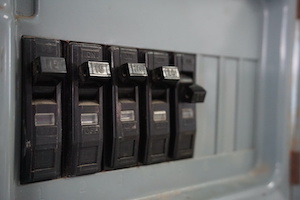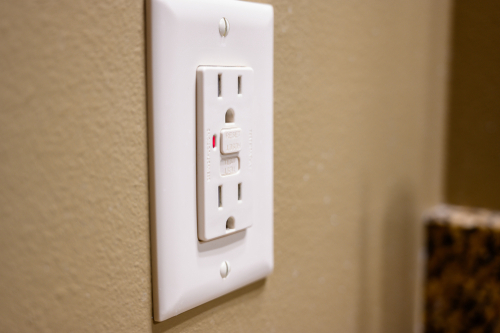Circuit Breaker Troubleshooting

Figure 1: Electrical panel with a tripped circuit breaker
Circuit breaker troubleshooting is an important process for anyone working with a circuit breaker, an important electrical system component. Breakers protect electrical appliances and wiring from overheating, fires, and electrical shocks by shutting off the flow of electricity when there is a problem. However, breakers can malfunction, which leads to power outages or even damage to the electrical system. This article discusses circuit breaker troubleshooting, including common symptoms of a bad breaker, the typical causes of malfunction, and the solutions to fix the problem.
Table of contents
View our online selection of circuit breakers!
What is a circuit breaker?
A circuit breaker is a safety device. If there is a fault in an electrical circuit, the breaker automatically shuts off power to said circuit. The shut-off protects electrical appliances from overheating and fires and protects people from electrical shocks. Read our circuit breaker overview article to learn more about how these devices work. Our articles on miniature circuit breakers and residual current circuit breakers offer insight into the working of specific breaker types.
Circuit breaker troubleshooting
This section describes how to troubleshoot whether or not a circuit breaker is bad. However, it is only sometimes apparent that a circuit breaker is malfunctioning. Without an obvious indication (e.g., the circuit breaker is overheating), it's helpful to first rule out overloading or short-circuiting as the reason why the breaker tripped.
- Overloading: Circuit breakers can only handle a certain amount of current flowing through the circuit. For example, homes in the U.S. typically have breakers that can handle 120V or 240V. A properly functioning circuit breaker will trip when the current exceeds this amount. To test for overloading, turn the circuit breaker off and remove anything connected to the circuit. Then, one by one, plug in and run the devices. At some point, if the circuit breaker trips again, it may be overloaded.
- Short circuit: A short circuit occurs when current flows directly from the phase wire to the neutral wire. This causes a spike in the current, and the circuit breaker should trip. In the previous discussion of overloading, the device that tripped the breaker may not have overloaded the circuit but may have short-circuited it. This can be tested by unplugging all devices and plugging in only the device in question. If the breaker trips, then it's very likely due to a short circuit and not due to overloading.
- Ground fault: A ground fault occurs when the current in a circuit takes an unintended path toward ground, which can be a metal component of a device, the ground, or a person. Specific types of breakers, for example, residual current devices, trip to interrupt the circuit if a ground fault is detected.
Bad circuit breaker symptoms
There are a variety of faulty circuit breaker symptoms, including:
- Breaker trips frequently: If overloading and short-circuiting have been ruled out as reasons for the breaker tripping, and the circuit breaker won't stay on, the cause is likely the circuit breaker itself is faulty. It can be dangerous if a circuit breaker keeps tripping, so it's important to investigate the cause of the tripping.
- Breaker won't reset: If all of the load on the circuit has been disconnected or turned off, and the circuit breaker won't reset, the breaker is likely broken.
- Burning smell: A defective circuit breaker that doesn't trip will overheat, leading to a burning smell.
- Hot to the touch: The circuit breaker's temperature should not exceed 60 °C (140 °F). This means the circuit breaker's plastic components should be touchable without a burning sensation. Another reason why a circuit breaker heats up is that the current flowing through it is sustained at just below the amount that would trip the current. This issue should be resolved.
- Circuit breaker won't turn on: If overloading and short-circuiting have been ruled out, and the circuit breaker still won't switch back on, it's likely faulty.
- Faulty spring: The spring that moves the breaker's switch to the tripped or off position may be faulty. In this case, the breaker trips, but the switch doesn't move. If a circuit in the building loses power, but none of the breakers appear to have tripped, check for a faulty spring. Do this by lightly tapping all of the switches toward the off position. Switches on breakers with functioning springs won't move. When lightly tapped, the switch with the faulty spring will easily move toward the off position. Replace a circuit breaker with a faulty spring.
Testing a circuit breaker with a multimeter
This section describes how to check a circuit breaker with a multimeter. A multimeter can give decisive input on whether or not a circuit breaker is functioning as it should. A user can perform two tests to determine the circuit breaker's status: resistance and voltage. Read our article on how to use a multimeter to learn more.
Resistance test - how to test a circuit breaker without power
- Wear insulated gloves.
- Turn off the power to the circuit breaker by switching off the main circuit breaker.
- Adjust the multimeter to measure resistance.
- Switch the breaker to the on position.
- Place the tool's red probe on the phase connection of the circuit breaker and its black probe on the neutral connection.
- A reading of 0 resistance indicates the circuit breaker is operating correctly.
- A reading of 0.003 ohms or higher indicates the circuit breaker is malfunctioning.
Voltage test
- Wear insulated gloves.
- Ensure there is power going through the circuit breaker. The main circuit breaker should be in the on position.
- Adjust the multimeter to measure voltage.
- Switch the breaker to the on position.
- Touch the multimeter's red probe to the breaker's phase connection. Touch the black probe to ground, such as the breaker panel's metal surface.
- The resulting voltage reading should be close to the amount of voltage the circuit breaker is designed for. For example, in a building with 120V circuit breakers, the reading can deviate slightly from 120V (110V to 125V). A significant deviation indicates that the breaker is not functioning properly.
Residual current circuit breakers
Residual current circuit breakers, such as a ground fault circuit interrupter (Figure 2) or an arc fault circuit interrupter, have test buttons to determine if the breaker is functioning. When the circuit breaker test button is pushed, it simulates a fault in the circuit, and the breaker should trip. If the breaker doesn't trip, it's malfunctioning and should be replaced immediately.

Figure 2: Ground fault circuit interrupters can be breakers in the breaker panel or installed directly into outlets. The test button simulates a fault, and the reset button turns the breaker back on.
The main circuit breaker won't turn back on
Main circuit breakers have switch springs with significantly higher force than branch breakers. Therefore, it may not be turning back on because not enough force is applied to flip the switch. If this is not the case, the main circuit breaker may be faulty and needs to be replaced. As a main circuit breaker connects directly to an external power source, it's advised to contact a licensed electrician to do this work.
Read our articles on smart circuit breakers and earth leakage circuit breakers for more details on the features of various circuit breaker types.
FAQs
Can a circuit breaker fail without tripping?
If a circuit breaker trips, it has not failed. It's working as it should. A circuit breaker failing may lead to it not tripping, which can cause overheating, fires, and electrical hazards.
Why won't the circuit breaker click back on?
A breaker may not click back on because there's a short circuit or overload in the circuit. If these have been ruled out, then it's not clicking back on because it's faulty and should be replaced.
Can a circuit breaker go bad?
Yes, a circuit breaker will experience wear and tear over time and eventually fail. Also, overheating and arcing can damage a circuit breaker. Finally, some breakers are bad before they're ever used. Always test a circuit breaker using a multimeter before installing it.





